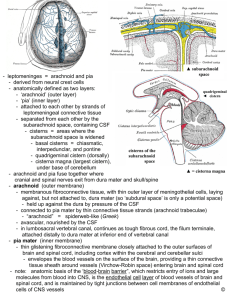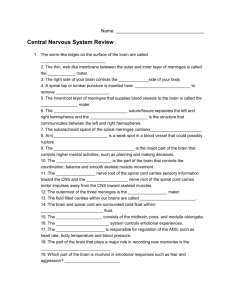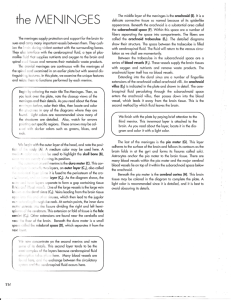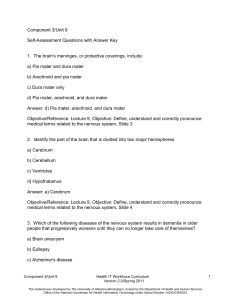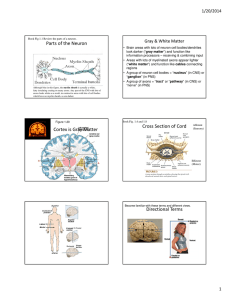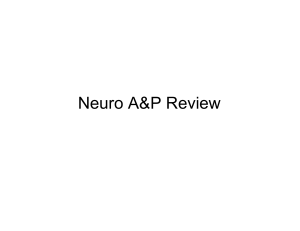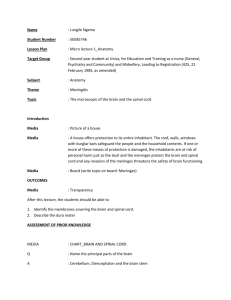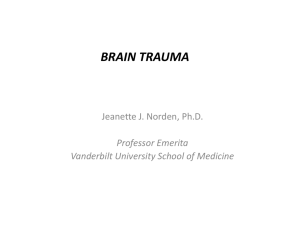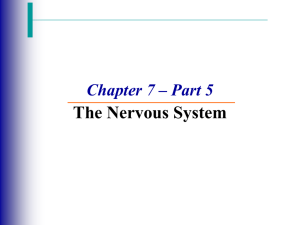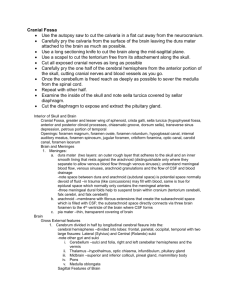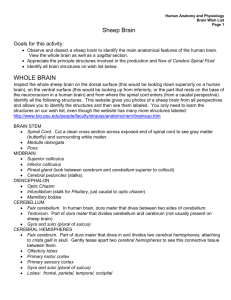CNS
advertisement
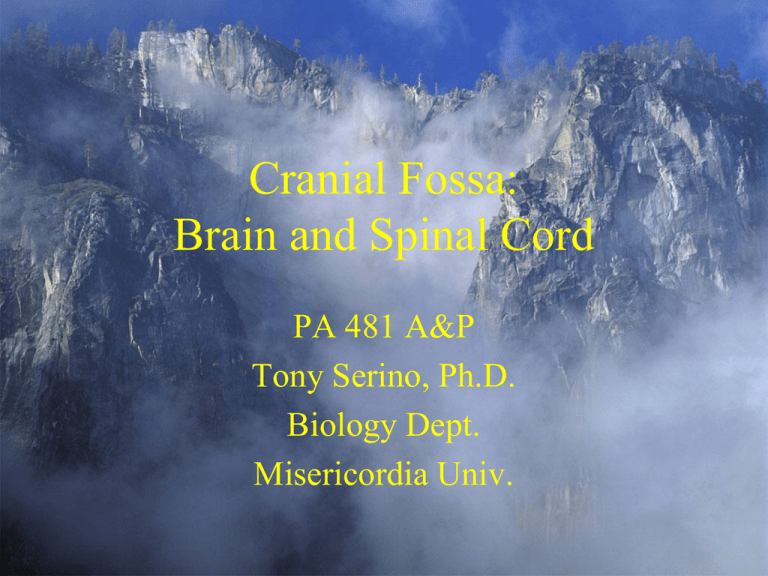
Cranial Fossa: Brain and Spinal Cord PA 481 A&P Tony Serino, Ph.D. Biology Dept. Misericordia Univ. Central Nervous System (CNS) • Gray vs. White matter • Protection of CNS – Meninges – CSF flow • Brain – Development – Selected structures • Spinal cord – Selected structures Cranial Fossa Anterior Middle Posterior CNS (Central Nervous System) • Brian and spinal cord • Displays gray and white matter – Gray matter are areas of CNS with many cell bodies of neurons present (little myelinated nerve fibers) – White matter are area of CNS with few cell bodies but many myelinated nerve fibers • Protected by bone and membranes Gray and White Matter • Since the cerebrum and cerebellum outgrow their cores, gray matter ends up on outside of both structures. Meninges • Dura Mater –outermost; tough, fibrous CT – In brain, divided into two layers (periosteal and meningeal) – In spine, only one layer with fat filled space above the layer called the epidural space • Arachnoid –middle; web-like appearance – Potential space between Dura and arachnoid is the subdural space • Pia Mater –innermost, delicate membrane fused with CNS surface – Space between Pia and Arachnoid is the subarachnoid space Meninges of the Spinal Cord Epidural space Subdural space Pia mater Arachnoid Dura mater Meninges Subarachnoid space Dorsal Root Ganglion Centrum Brain Meninges Extensions of Dura Mater hold brain in cavity Sellar diaphragm (not shown) Venous Sinuses of Cranium Superior Sagittal Inf. Sagittal Straight Transverse Sigmoid Cavernous Lateral Venous Lacunae Arachnoid villi Middle Meningeal Artery Middle Meningeal A. Maxillary A. Brain Ventricles Choroid Plexus CSF (cerebral-spinal fluid) Flow Hydrocephalus • Blockage of CSF flow can lead to severe brain and/or head enlargement. • In an adult, such swelling would be fatal. Brain • Development • Structures • Functional Areas Neural Tube forming Neural Tube Brain Vesicles Flexures and Cerebral Cortex Growth Major Divisions of Brain Brain Stem = midbrain + pons + medulla Brain Anatomy (req’d) Projections vs. Commissures Functional Anatomy of Brain Functional Areas of Cerebrum Primary Motor and Somatosensory Gyri Basal Nuclei: cerebral nuclei Putamen and Globus Pallidus Subthalamic nuclei and the Substantia nigra are usually included Reticular Formation Extends along length of brain stem; used in maintaining alertness while awake; also includes motor nuclei such as centers for Cardiac, Respiratory and Vasomotor control. RAS receives inputs from eye, ear and genral sensation to maintain alertness Limbic System: functional system; responsible for emotion and memory Cingulate Gyrus Fornix Mammillary body Hypothalamus Control of Pituitary Posterior Pituitary Anterior Pituitary Pineal Gland • Plays a major role in circadian rhythm control through its sympathetic connection to the hypothalamus • Melatonin increases at night and decreases during daylight • Implicated in the control of major life changes (such as the onset of puberty and adulthood Internal Carotid Artery Blood Supply (Circle of Willis) Ant. Cerebral Ant. Communicating Middle Cerebral Internal Carotid A. Post. Communicating Post. Cerebral Basilar A. Vertebral A.
